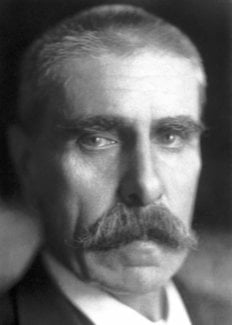Julius Wagner-Jauregg
Biographical

Julius Wagner – his father Adolf Johann Wagner was granted the title “Ritter von Jauregg” only in 1883 – was born on March 7, 1857, in Wels, Austria. He attended the famous old Schottengymnasium in Vienna and started reading medicine at Vienna University in 1874.
From 1874 to 1880 he studied with Salomon Stricker, in the Institute of General and Experimental Pathology, obtaining his doctor’s degree in 1880 with a thesis entitled “L’origine et la fonction du coeur accélére” (Origin and function of the accelerated heart). He left the Institute in 1882. It was during this period that Wagner-Jauregg became acquainted with the use of laboratory animals in experimental work – a practice little followed at that time.
For a short period he worked in the Department for Internal Diseases under Bamberger, but gladly accepted the post of assistant to Leidesdorf in the Psychiatric Clinic in 1883, although he had never previously considered the possibility of becoming a psychiatrist and had practically no experience of this specialized field. Nevertheless, he was invited to lecture on the pathology of the nervous system already in 1885 and three years later this field was extended to include psychiatry. In 1887 his chief, Leidesdorf, fell ill and Wagner-Jauregg took charge of the clinic. In 1889 he was appointed Extraordinary Professor at the Medical Faculty of the University of Graz as successor to Krafft-Ebing and Director of the Neuro-Psychiatric Clinic. It was there that he started his investigations on the connections between goitre and cretinism; on his advice the Government, some time later, started selling salt to which iodine had been added, in the areas most affected by goitre.
In 1892 followed the appointment to the “Landesirrenanstalt” (State Lunatic Asylum) and in 1893 he became Extraordinary Professor of Psychiatry and Nervous Diseases, and Director of the Clinic for Psychiatry and Nervous Diseases in Vienna, as successor to Meynert. Ten years later, in 1902, Wagner-Jauregg moved to the psychiatric clinic at the “Allgemeines Krankenhaus” (General Hospital) as this offered more scope and a more varied activity. However, when in 1911 the “Landesirrenanstalt” was rebuilt and enlarged on the outskirts of Vienna at Steinhof, thus making the setting up of a larger psychiatric-neurological department, Wagner-Jauregg returned to his former post.
Wagner-Jauregg’s initial study was concerned with the origin and function of the N. accelerantes, and this was followed by another on the respiratory function of the N. vagus.
The main work that concerned Wagner-Jauregg throughout his working life was the endeavour to cure mental disease by inducing a fever. Already in 1887 he systematically investigated the effects of febrile diseases on psychoses, later also making use of tuberculin (discovered in 1890 by Robert Koch). As this and similar methods of treatment did not yield satisfactory results, he turned in 1917 to malaria inoculation, which proved to be very successful in the case of dementia paralytica. This discovery earned him the Nobel Prize in 1927. His numerous other distinctions included the Cameron Prize (1935)
Among his numerous publications may be mentioned: Myxödem und Kretinismus, in the Handbuch der Psychiatrie, (1912); Lehrbuch der Organotherapie (Textbook of organotherapy), with G. Bayer, (1914); Verhütung und Behandlung der progressiven Paralyse durch Impfmalaria (Prevention and treatment of progressive paralysis by malaria inoculation) in the Memorial Volume of the Handbuch der experimentellen Therapie, (1931).
Wagner-Jauregg occupied himself also intensively with questions concerning forensic medicine and the legal aspects of insanity; he assisted in formulating the law regarding certification of the insane, which is still in force in Austria today. In recognition of his services to forensic medicine he was awarded the diploma of Doctor of Law.
Wagner-Jauregg was judged by his pupils and friends to be rather reserved, cool and aloof, but was generally respected, and all his students were proud to work under him. He worked very hard and conscientiously, and was well known for his sense of justice. Among his numerous pupils should be mentioned C. von Economo, who in 1917 isolated epidemic encephalitis (since then also called Economo’s disease) – a discovery giving rise to the abolishment of certain classical views in neurology.
Professor Wagner-Jauregg married Anna Koch. There were two children from this marriage: Julia (b. 1900) now Mrs. Humann-Wagner Jauregg, and Theodor (b. 1903) now “Privatdozent” in Chemistry at the University of Vienna.
In 1928, Wagner-Jauregg retired from his post in Steinhof, but was by no means idle, publishing about 80 scientific papers after his retirement. He enjoyed good health and remained active until his death on September 27, 1940.
This autobiography/biography was written at the time of the award and first published in the book series Les Prix Nobel. It was later edited and republished in Nobel Lectures. To cite this document, always state the source as shown above.
The Nobel Foundation's copyright has expired.Nobel Prizes and laureates
Six prizes were awarded for achievements that have conferred the greatest benefit to humankind. The 14 laureates' work and discoveries range from quantum tunnelling to promoting democratic rights.
See them all presented here.
